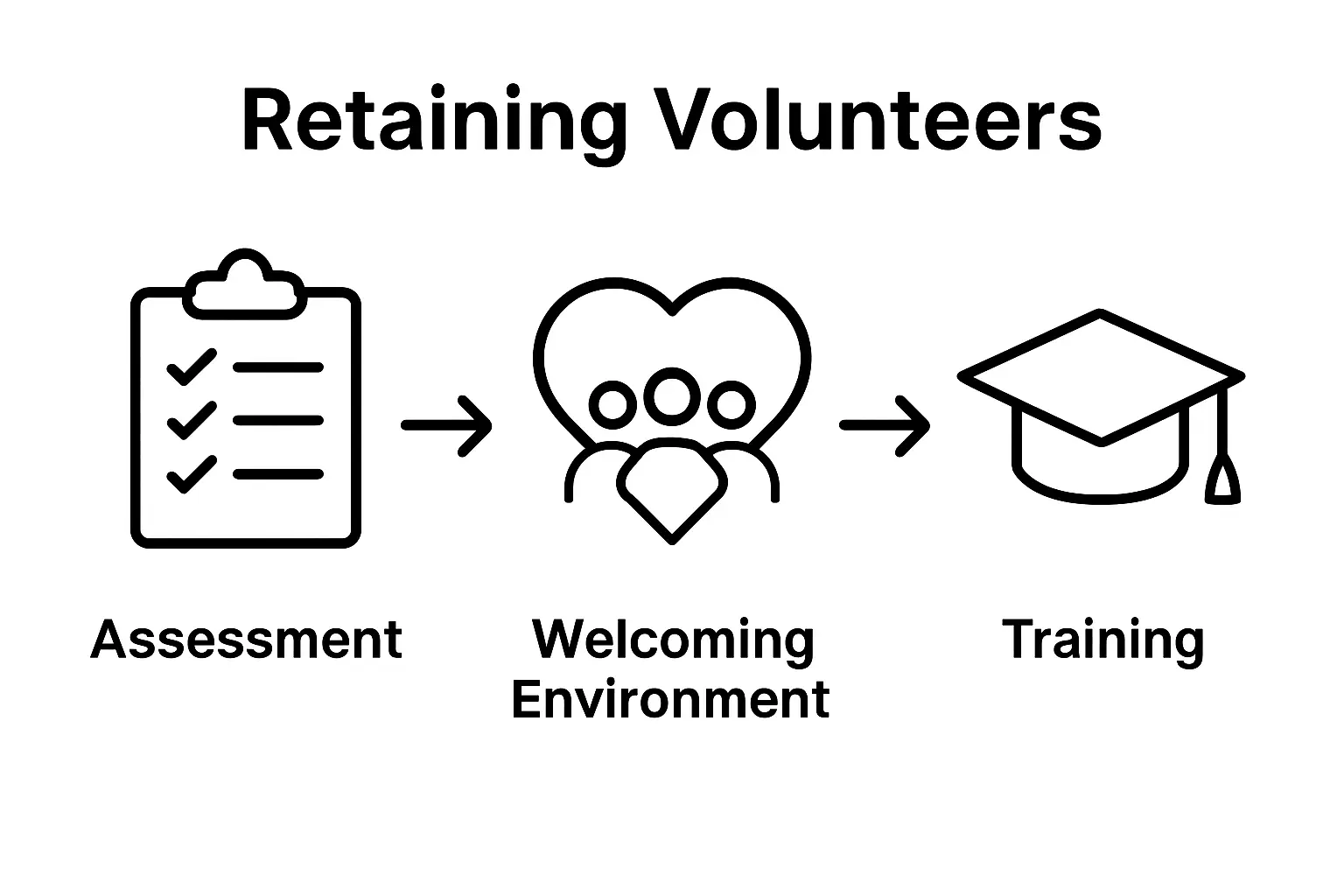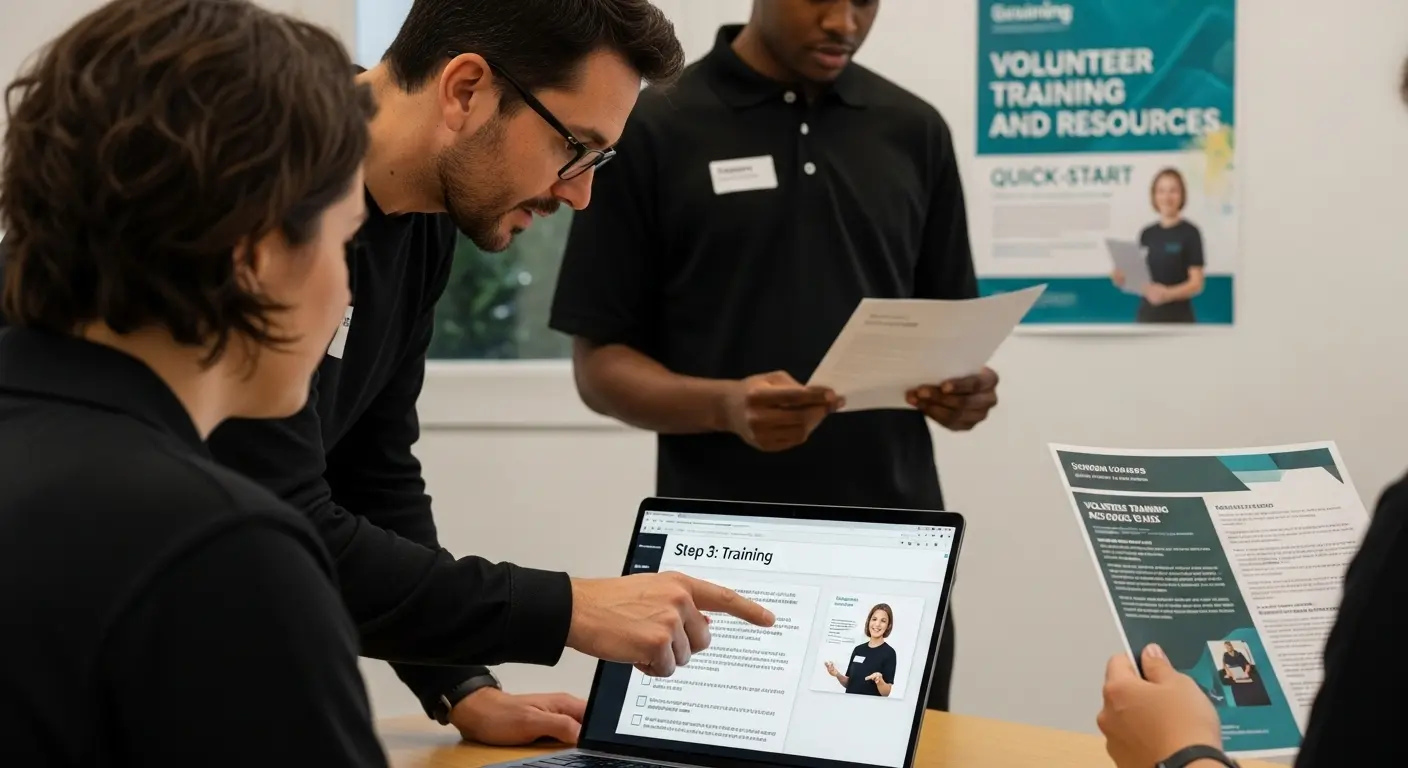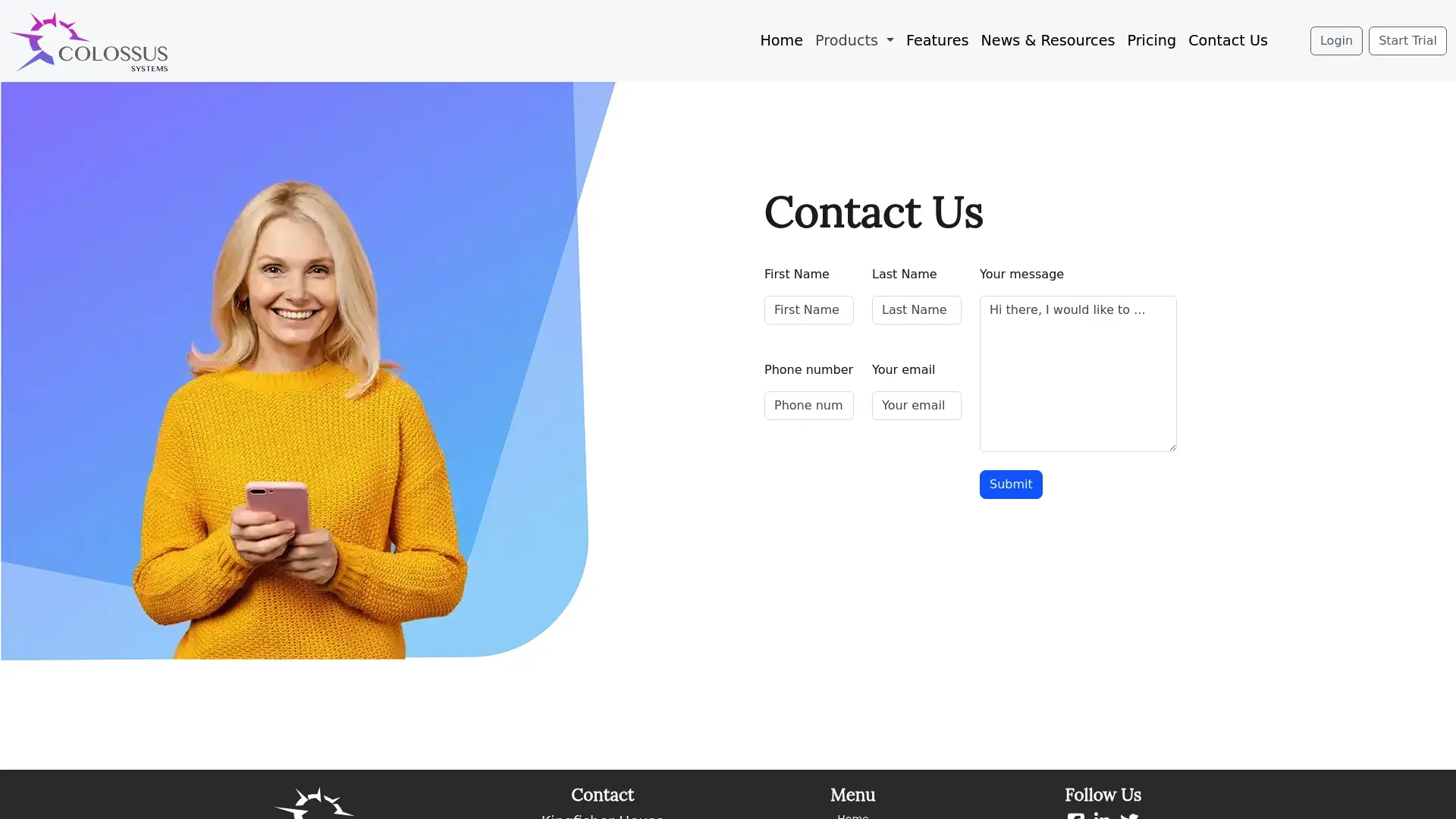How to Retain Volunteers: Enhance Engagement and Commitment

Retaining passionate volunteers can shape the future of any organisation. Some groups find it tough to hold onto their members for just one year, with volunteer turnover rates reaching up to 45 percent in the UK. Yet that is not the real story. The real breakthrough comes from systematic tweaks that can quietly transform an average volunteer programme into one where people stay, thrive, and inspire others to join.
Table of Contents
- Step 1: Assess Your Current Volunteer Retention Strategies
- Step 2: Foster A Welcoming And Inclusive Environment
- Step 3: Provide Comprehensive Training And Resources
- Step 4: Establish Clear Communication Channels
- Step 5: Recognise And Reward Volunteer Contributions
- Step 6: Evaluate And Adjust Retention Tactics Regularly
Quick Summary
| Key Point | Explanation |
|---|---|
| 1. Assess current volunteer strategies | Evaluate existing methods to identify strengths and areas for improvement in volunteer retention. |
| 2. Foster an inclusive environment | Create a welcoming space where all volunteers feel valued and connected to the mission. |
| 3. Provide ongoing training and resources | Implement continuous development opportunities that enhance skills and volunteer confidence. |
| 4. Establish clear communication channels | Ensure messages are consistent and accessible, fostering engagement and trust among volunteers. |
| 5. Regularly evaluate retention tactics | Continuously assess strategies to adapt to volunteer needs and maintain engagement effectively. |
Step 1: Assess Your Current Volunteer Retention Strategies
Successful volunteer retention begins with a comprehensive evaluation of your existing strategies. Understanding your current approach allows you to identify strengths, pinpoint weaknesses, and develop targeted improvements that will help you keep dedicated volunteers engaged.
To start this assessment, gather comprehensive data about your volunteer programme. Review historical records, tracking metrics such as volunteer turnover rates, average volunteer duration, and reasons volunteers have left in the past. These insights provide a critical foundation for understanding your organization’s volunteer engagement landscape. Learn more about effective community engagement tactics to support your initial assessment.
Conduct a thorough internal audit by creating a structured survey for current and former volunteers. Ask direct questions about their experiences, motivations, challenges, and suggestions for improvement. Include qualitative questions that reveal deeper insights beyond simple numerical ratings. For instance, inquire about what initially attracted them to volunteer, what keeps them motivated, and what potential barriers might discourage their continued participation.
Analyze the collected data systematically, looking for recurring themes and patterns. Pay special attention to:
- Volunteer satisfaction levels
- Frequency and quality of communication
- Alignment between volunteer expectations and actual experiences
- Opportunities for skill development and personal growth
- Recognition and appreciation mechanisms
This comprehensive review will help you understand the intricate dynamics of your volunteer ecosystem. By identifying gaps and opportunities, you can develop a more strategic approach to volunteer retention that addresses specific organizational needs and volunteer preferences.

Step 2: Foster a Welcoming and Inclusive Environment
Creating a welcoming and inclusive environment is fundamental to volunteer retention and engagement. Volunteers are more likely to remain committed when they feel valued, respected, and connected to the organization’s mission and community. Check out our guide on onboarding new members to enhance your initial engagement strategies.
Begin by developing a comprehensive orientation programme that goes beyond basic task training. This programme should introduce volunteers to the organization’s core values, demonstrate how their individual contributions matter, and provide clear pathways for involvement. Ensure that the initial welcome process is warm, informative, and designed to make volunteers feel immediately appreciated and integrated.
Diversity and inclusion must be more than just buzzwords in your volunteer programme. Actively work to create an environment that welcomes individuals from all backgrounds, abilities, and experiences. This means implementing inclusive recruitment practices, providing accessibility accommodations, and creating communication channels that allow every volunteer to feel heard and respected.
Establish mentorship and buddy systems that pair new volunteers with experienced team members. These relationships help newcomers navigate the organization, provide emotional support, and create a sense of belonging. Mentors can offer guidance, share institutional knowledge, and help new volunteers feel more confident in their roles.
Regularly collect and act on volunteer feedback through structured mechanisms. Create anonymous surveys, host focus groups, and maintain open communication channels that allow volunteers to share their experiences, suggestions, and concerns. Demonstrating that you not only listen but also implement changes based on their input will significantly enhance volunteer satisfaction and commitment.
Below is a checklist table to help you verify key indicators that show whether your volunteer environment is inclusive and welcoming.
| Indicator | What to Look For |
|---|---|
| High retention rates | Volunteers stay with the organisation long-term |
| Positive satisfaction feedback | Volunteers report feeling valued and included |
| Diverse volunteer demographics | Participation from various backgrounds and abilities |
| Active, engaged community | Volunteers regularly attend and contribute to activities |
| Reduced turnover | Fewer volunteers leaving prematurely |
Key indicators of a successful inclusive environment include:
- High volunteer retention rates
- Positive feedback in volunteer satisfaction surveys
- Diverse volunteer demographics
- Active and engaged volunteer community
- Reduced volunteer turnover
Step 3: Provide Comprehensive Training and Resources
Comprehensive training and resource provision are critical components of volunteer engagement and retention. Volunteers need more than just initial orientation; they require ongoing professional development, clear guidance, and the necessary tools to excel in their roles. Explore our guide on staff training best practices to enhance your approach.
Design a multi-tiered training programme that addresses both skill development and organizational understanding. This approach should begin with a robust onboarding process that introduces volunteers to the organization’s mission, values, and specific role expectations. Develop customized training modules that cater to different volunteer roles, ensuring each individual receives targeted instruction relevant to their responsibilities.
Integrate both in-person and digital learning opportunities to accommodate diverse learning preferences and schedules. Create comprehensive online training resources that volunteers can access flexibly, including video tutorials, interactive modules, and downloadable reference materials. These digital resources enable volunteers to refresh their skills, learn at their own pace, and feel continuously supported by the organization.
Establish a mentorship framework where experienced volunteers can provide guidance and support to newer team members. This approach not only facilitates knowledge transfer but also creates a sense of community and belonging. Experienced volunteers can share insights, offer practical advice, and help newcomers navigate potential challenges more effectively.
Consider implementing a continuous feedback mechanism that allows volunteers to assess the effectiveness of training programmes and suggest improvements. Regular skill assessments and performance reviews can help identify individual development needs and demonstrate the organization’s commitment to volunteer growth and empowerment.
Key indicators of successful training and resource provision include:

- High volunteer skill proficiency
- Increased volunteer confidence
- Positive feedback on training resources
- Reduced volunteer turnover
- Enhanced organizational performance
Step 4: Establish Clear Communication Channels
Effective communication is the lifeblood of successful volunteer programmes. Establishing robust communication channels ensures volunteers feel informed, valued, and connected to the organization’s mission. Learn more about enhancing leadership communication skills to support your volunteer engagement strategy.
Begin by developing a comprehensive communication strategy that utilizes multiple platforms and approaches. This means creating a mix of digital and traditional communication methods that cater to different volunteer preferences and availability. Implement a combination of email newsletters, dedicated messaging platforms, regular team meetings, and periodic one-on-one check-ins to maintain consistent and meaningful dialogue.
Create a centralized communication hub where volunteers can easily access important information, share updates, and connect with team members. This could be a digital platform like a shared online workspace, a private social media group, or a customized communication portal. Ensure the platform is user-friendly, accessible, and provides clear guidelines for interaction and information sharing.
Establish a transparent communication protocol that outlines expectations for response times, communication frequency, and preferred communication channels.
Volunteers should understand how and when they can expect to receive updates, ask questions, and provide feedback. Consistency is key in building trust and maintaining volunteer engagement.
Implement a structured feedback mechanism that allows volunteers to share their experiences, challenges, and suggestions openly. This could include anonymous surveys, quarterly feedback sessions, or dedicated communication channels for constructive dialogue. Demonstrating that you actively listen and respond to volunteer input will significantly enhance their sense of belonging and commitment.
Key indicators of successful communication channels include:
- High volunteer engagement in communication platforms
- Timely and comprehensive information sharing
- Positive feedback on communication effectiveness
- Increased volunteer satisfaction and retention
- Transparent and open organizational culture
Step 5: Recognise and Reward Volunteer Contributions
Recognition transforms volunteer efforts from mere task completion to meaningful engagement. Acknowledging individual contributions is fundamental to maintaining motivation and demonstrating genuine appreciation for volunteers’ dedication. Explore strategies for effective leadership recognition to enhance your volunteer appreciation approach.
Develop a multifaceted recognition programme that goes beyond traditional appreciation methods. This strategy should include both formal and informal acknowledgement mechanisms that cater to different volunteer personalities and preferences. Implement a mix of public and private recognition approaches, understanding that some volunteers appreciate public acknowledgement while others prefer more personal, discrete appreciation.
Create a structured recognition framework that celebrates volunteers at different milestones and performance levels. This could include monthly spotlight features, quarterly achievement awards, and annual recognition events. Consider developing a points-based system where volunteers can accumulate recognition credits for their contributions, which can be exchanged for meaningful rewards such as specialised training opportunities, organisational merchandise, or exclusive experiences.
Personalise recognition efforts by understanding each volunteer’s motivations and preferences. Conduct individual conversations to learn what type of acknowledgement resonates most with them. Some volunteers might value professional development opportunities, while others might appreciate a heartfelt thank-you note or a leadership recommendation. Tailoring recognition demonstrates that your organisation values each volunteer as an individual.
Here is a comparison table of different volunteer recognition methods discussed in the article to help identify which approaches best suit your volunteers.
| Recognition Method | Formal or Informal | Typical Format | Key Benefits |
|---|---|---|---|
| Public recognition | Formal | Awards, spotlight features | Boosts morale, shows value to wider audience |
| Private appreciation | Informal | Thank-you notes, one-on-one praise | Personalises recognition, caters to reserved volunteers |
| Milestone rewards | Formal | Quarterly/annual awards, special events | Celebrates long-term commitment, motivates continued service |
| Points-based system | Formal | Accumulate and exchange credits | Offers tangible rewards, encourages active participation |
| Personalised development | Informal/Formal | Training, recommendations | Supports individual growth, tailored to volunteer goals |
Establish transparent criteria for recognition to ensure fairness and maintain volunteer trust. Develop clear guidelines that outline how volunteers can earn different levels of recognition, ensuring the process feels objective and achievable. Regular communication about recognition opportunities will help volunteers understand how their efforts contribute to the organisation’s broader mission.
Key indicators of successful volunteer recognition include:
- Increased volunteer retention rates
- Positive feedback on recognition programmes
- Higher volunteer engagement levels
- Improved organisational reputation
- Enhanced volunteer satisfaction and motivation
Step 6: Evaluate and Adjust Retention Tactics Regularly
Volunteer retention is a dynamic process that requires continuous assessment and strategic refinement. Implementing a systematic approach to evaluation ensures your organisation remains responsive to changing volunteer needs and expectations. Explore strategies for growing membership and engagement to support your ongoing retention efforts.
Design a comprehensive evaluation framework that goes beyond simple metrics. Develop a holistic assessment process that captures both quantitative data and qualitative insights. This means collecting numerical information like volunteer retention rates, hours contributed, and participation levels, alongside more nuanced feedback about volunteer experiences, motivations, and potential barriers to continued engagement.
Conduct regular structured surveys and feedback sessions that provide volunteers with multiple channels to share their experiences. Create anonymous questionnaires that allow for honest, unfiltered input about their volunteer journey. Schedule periodic one-on-one conversations and group feedback forums that enable deeper exploration of volunteer perspectives, challenges, and suggestions for improvement.
Establish a dedicated review committee responsible for analyzing evaluation data and recommending strategic adjustments. This team should meet quarterly to review collected insights, identify emerging trends, and develop targeted interventions to address potential retention challenges. Ensure the committee includes a diverse representation of volunteers, staff members, and organizational leadership to provide comprehensive perspectives.
Implement an agile approach to volunteer management that allows for rapid adaptation of strategies based on evaluation findings. Be prepared to modify training programmes, communication channels, recognition methods, and support systems in response to volunteer feedback. Demonstrating a commitment to continuous improvement will reinforce volunteers’ sense of value and organizational responsiveness.
Key indicators of effective evaluation and adjustment include:
- Consistent volunteer engagement levels
- Reduced volunteer turnover rates
- Positive feedback on organizational adaptability
- Increased volunteer satisfaction scores
- Proactive identification and resolution of potential retention challenges
Ready To Transform Your Volunteer Engagement And Retention?
If you are struggling to keep volunteers motivated or find it challenging to create a truly inclusive volunteer experience, you are not alone. Many organisations face the same issues: volunteers drifting away due to lack of recognition, insufficient training, or unclear communication. The strategies discussed in this article, such as comprehensive training, robust recognition, and clear communication channels, are crucial. Yet, implementing these effectively can feel overwhelming without the right tools. What if you could automate and streamline every step—engagement, training, communication, and reporting—within a single platform tailored for membership organisations?

Unlock the full potential of your volunteer retention strategies today. With Colossus Systems, you gain access to all-in-one solutions covering CRM, volunteer onboarding, event management, recognition tools, and intuitive communication channels—all designed with organisations like yours in mind. Take control of your volunteer journey, see measurable retention improvements, and build a thriving, committed volunteer community. Contact our team now to discover how you can keep every volunteer engaged and coming back for more. There has never been a better time to invest in your volunteers’ experience and your organisation’s future.
Frequently Asked Questions
How can I assess my current volunteer retention strategies?
To evaluate your volunteer retention strategies, gather data on volunteer turnover rates, average duration of service, and reasons for departure. Conduct surveys with current and former volunteers to gain insights into their experiences and suggestions for improvement.
What steps can I take to create a welcoming environment for volunteers?
Develop a comprehensive orientation programme that introduces volunteers to your organisation’s values and mission. Additionally, establish mentorship systems to support new volunteers and actively implement diversity and inclusion practices to ensure all volunteers feel valued and respected.
How important is ongoing training for volunteer retention?
Ongoing training is crucial as it empowers volunteers by enhancing their skills and confidence. Providing access to both in-person and digital training resources ensures that volunteers feel supported and can excel in their roles, ultimately leading to higher retention rates.
What recognition strategies can help retain volunteers?
Implement a multifaceted recognition programme that includes both formal and informal methods of appreciation. Personalise recognition efforts based on individual preferences and ensure transparency in criteria to build trust and maintain motivation among volunteers.
Recommended
- Effective Community Engagement Tactics for Lasting Connections|CS
- 7 Effective Youth Engagement Strategies for 2025 | Colossus Systems
- How to Grow Membership: Proven Strategies for Organisations|CS
- Improving Member Engagement: Proven Strategies for 2025|CS
- How to Increase Website Engagement in 2025: Proven Strategies